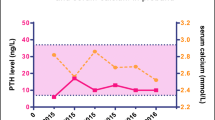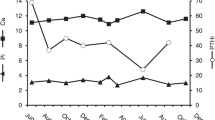Abstract
We describe the case of an adult female patient with symptomatic familial hypocalciuric hypercalcemia requiring a step-wise therapeutic approach and the eventual need for a total parathyroidectomy and thyroidectomy to cure symptoms. Genetic analysis demonstrated a heterozygous R227L inactivating CASR gene variant, previously only described in neonatal severe hyperparathyroidism. Post-operative histology showed diffuse hyperplasia of all four parathyroid glands along with the presence of intrathyroidal parathyroid tissue. With regard to clinical management this case suggests that familial hypocalciuric hypercalcemia should be classified as an atypical form of primary hyperparathyroidism rather than a distinct entity.

Similar content being viewed by others
References
Glaudo M, Letz S, Quinkler M, Bogner U, Elbelt U, Strasburger CJ, Schnabel D, Lankes E, Scheel S, Feldkamp J, Haag C, Schulze E, Frank-Raue K, Raue F, Mayr B, Schofl C (2016) Heterozygous inactivating CaSR mutations causing neonatal hyperparathyroidism: function, inheritance and phenotype. Eur J Endocrinol 175:421–431
Marx SJ, Goltzman D (2019) Evolution of our understanding of the hyperparathyroid syndromes: a historical perspective. J Bone Miner Res 34:22–37
Hendy GN, D'Souza-Li L, Yang B, Canaff L, Cole DE (2000) Mutations of the calcium-sensing receptor (CASR) in familial hypocalciuric hypercalcemia, neonatal severe hyperparathyroidism, and autosomal dominant hypocalcemia. Hum Mutat 16:281–296
Marx SJ (2018) Familial hypocalciuric hypercalcemia as an atypical form of primary hyperparathyroidism. J Bone Miner Res 33:27–31
Hendy GN, Guarnieri V, Canaff L (2009) Calcium-sensing receptor and associated diseases. Prog Mol Biol Transl Sci 89:31–95
Marx SJ, Attie MF, Stock JL, Spiegel AM, Levine MA (1981) Maximal urine-concentrating ability: familial hypocalciuric hypercalcemia versus typical primary hyperparathyroidism. J Clin Endocrinol Metab 52:736–740
Rodrigues LS, Cau AC, Bussmann LZ, Bastida G, Brunetto OH, Correa PH, Martin RM (2011) New mutation in the CASR gene in a family with familial hypocalciuric hypercalcemia (FHH) and neonatal severe hyperparathyroidism (NSHPT). Arq Bras Endocrinol Metabol 55:67–71
Pearce SH, Trump D, Wooding C, Besser GM, Chew SL, Grant DB, Heath DA, Hughes IA, Paterson CR, Whyte MP et al (1995) Calcium-sensing receptor mutations in familial benign hypercalcemia and neonatal hyperparathyroidism. J Clin Investig 96:2683–2692
Wilhelm SM, Wang TS, Ruan DT, Lee JA, Asa SL, Duh QY, Doherty GM, Herrera MF, Pasieka JL, Perrier ND, Silverberg SJ, Solorzano CC, Sturgeon C, Tublin ME, Udelsman R, Carty SE (2016) The American association of endocrine surgeons guidelines for definitive management of primary hyperparathyroidism. JAMA Surg 151:959–968
Khan AA, Hanley DA, Rizzoli R, Bollerslev J, Young JE, Rejnmark L, Thakker R, D'Amour P, Paul T, Van Uum S, Shrayyef MZ, Goltzman D, Kaiser S, Cusano NE, Bouillon R, Mosekilde L, Kung AW, Rao SD, Bhadada SK, Clarke BL, Liu J, Duh Q, Lewiecki EM, Bandeira F, Eastell R, Marcocci C, Silverberg SJ, Udelsman R, Davison KS, Potts JT Jr, Brandi ML, Bilezikian JP (2017) Primary hyperparathyroidism: review and recommendations on evaluation, diagnosis, and management. Can Int Consens 28:1–19
Thorgeirsson U, Costa J, Marx SJ (1981) The parathyroid glands in familial hypocalciuric hypercalcemia. Hum Pathol 12:229–237
Burski K, Torjussen B, Paulsen AQ, Boman H, Bollerslev J (2002) Parathyroid adenoma in a subject with familial hypocalciuric hypercalcemia: coincidence or causality? J Clin Endocrinol Metab 87:1015–1016
Gouveia S, Rodrigues D, Barros L, Ribeiro C, Albuquerque A, Costa G, Carvalheiro M (2012) Persistent primary hyperparathyroidism: an uncommon location for an ectopic gland: case report and review. Arq Bras Endocrinol Metabol 56:393–403
Chen M, Zhou WB, Xu JF, Sun K (2017) Primary hyperparathyroidism caused by mediastinal ectopic parathyroid adenoma. Hong Kong Med J 23:411–413
Phitayakorn R, McHenry CR (2006) Incidence and location of ectopic abnormal parathyroid glands. Am J Surg 191:418–423
Yabuta T, Miyauchi A, Inoue H, Yoshida H, Hirokawa M, Amino N (2009) A patient with primary hyperparathyroidism associated with familial hypocalciuric hypercalcemia induced by a novel germline CaSR gene mutation. Asian J Surg 32:118–122
Wystrychowski A, Pidasheva S, Canaff L, Chudek J, Kokot F, Wiecek A, Hendy GN (2005) Functional characterization of calcium-sensing receptor codon 227 mutations presenting as either familial (benign) hypocalciuric hypercalcemia or neonatal hyperparathyroidism. J Clin Endocrinol Metabol 90:864–870
Lee JY, Shoback DM (2018) Familial hypocalciuric hypercalcemia and related disorders. Best Pract Res Clin Endocrinol Metab 32:609–619
Chou YH, Pollak MR, Brandi ML, Toss G, Arnqvist H, Atkinson AB, Papapoulos SE, Marx S, Brown EM, Seidman JG et al (1995) Mutations in the human Ca(2+)-sensing-receptor gene that cause familial hypocalciuric hypercalcemia. Am J Hum Genet 56:1075–1079
Bollerslev J, Rejnmark L, Marcocci C, Shoback DM, Sitges-Serra A, van Biesen W, Dekkers OM (2015) European Society of E: European Society of Endocrinology Clinical Guideline: treatment of chronic hypoparathyroidism in adults. Eur J Endocrinol 173:G1–20
Bollerslev J, Schalin-Jantti C, Rejnmark L, Siggelkow H, Morreau H, Thakker R, Sitges-Serra A, Cetani F, Marcocci C (2019) Management of endocrine disease: unmet therapeutic, educational and scientific needs in parathyroid disorders. Eur J Endocrinol 181:P1–P19
Funding
This research did not receive any specific grant from funding agencies in the public, commercial, or not-for-profit sectors.
Author information
Authors and Affiliations
Contributions
LV conducted patient data collection and wrote the first draft. SR coordinated the diagnostic assessment, treatment and follow-up of the patient. SR, JB and BD helped writing the draft and critically reviewed it. JB reviewed the genetic analysis. BW reviewed the histopathology.
Corresponding author
Ethics declarations
Conflict of interest
Laurens Veldeman, Saskia Robbrecht, Jeroen Breckpot, Birgit Weynand and Brigitte Decallonne declare that they have no conflicts of interest.
Human and Animal Rights and Informed Consent
This article does not contain any studies with human or animal subjects performed by any of the authors.
Additional information
Publisher's Note
Springer Nature remains neutral with regard to jurisdictional claims in published maps and institutional affiliations.
Electronic supplementary material
Below is the link to the electronic supplementary material.
223_2020_693_MOESM1_ESM.pdf
Supplementary file1 (PDF 117 kb) Supplemental Figure 1. Electropherogram of CaSR exon 4 fragment, wild type (WT) and proband (P), black box shows nucleotide change point mutation G→T substitution in codon 680 in heterozygous state, leading to amino acid change position 227 Arginine (R) to Leucine (L).
Rights and permissions
About this article
Cite this article
Veldeman, L., Robbrecht, S., Breckpot, J. et al. A Case of a Heterozygous Inactivating CASR Variant with Adult-Onset Symptomatic Hypercalcemia Requiring Extensive Surgery. Calcif Tissue Int 107, 104–108 (2020). https://doi.org/10.1007/s00223-020-00693-4
Received:
Accepted:
Published:
Issue Date:
DOI: https://doi.org/10.1007/s00223-020-00693-4




